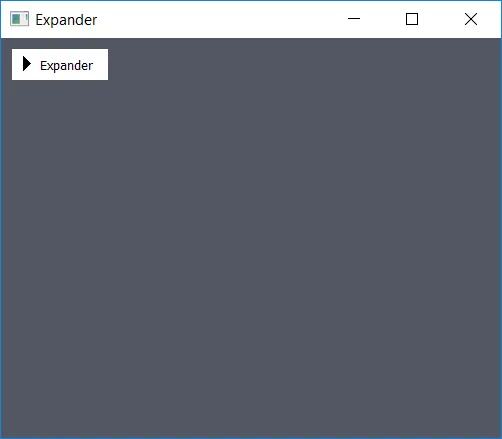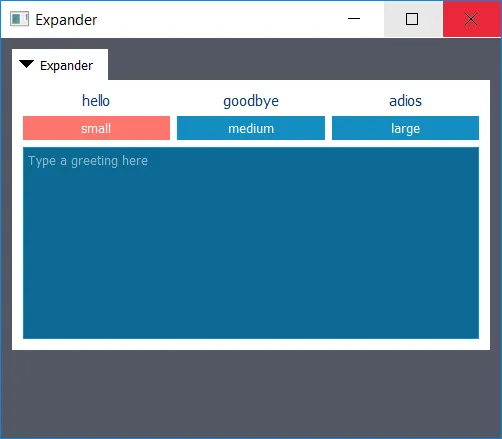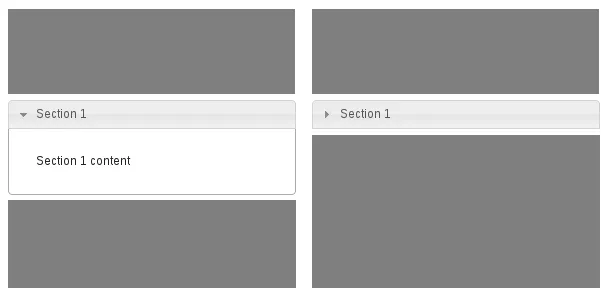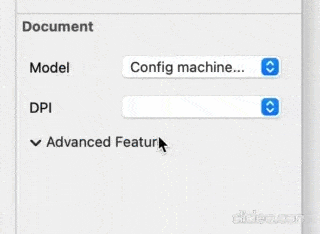我建立了一个使用
Python3/Qt5风格的示例来测试我正在编写的StyleSheet类。我还修复了一个大小计算问题,该问题没有考虑到扩展器按钮的大小更改。
我还将方法更改为
setLayout(),以与Qt保持一致。


import sys
import inspect
import textwrap
from collections import OrderedDict, UserString
from PyQt5 import QtCore, QtGui
from PyQt5.QtCore import Qt
from PyQt5.QtGui import QIcon
from PyQt5.QtWidgets import *
class QStyleSheet(UserString):
"""
Represent stylesheets as dictionary key value pairs.
Update complex stylesheets easily modifying only the attributes you need
Allow for attribute inheritance or defaulting of stylesheets.
# TODO support [readOnly="true"] attribute-selectors
QTextEdit, QListView <-- you can have multiple classes.
QCheckBox::indicator <-- some psuedo classes have double colons
"""
def __init__(self, cls=None, name=None, psuedo=None, **styles):
"""
Arguments to the constructor allow you to default different properties of the CSS Class.
Any argument defined here will be global to this StyleSheet and cannot be overidden later.
:param cls: Default style prefix class to ``cls``
:param name: Default object name to ``name`` (hashtag) is not needed.
:param psuedo: Default psuedo class to ``psuedo``, example: ``:hover``
"""
self.cls_scope = cls
self.psuedo_scope = psuedo
self.name_scope = name
self._styles = OrderedDict()
if styles:
self.setStylesDict(OrderedDict(styles))
def _ident(self, cls=None, name=None, psuedo=None):
if cls is not None and not inspect.isclass(cls):
raise ValueError(f'cls must be None or a class object, got: {type(cls)}')
if name is not None and not isinstance(name, str):
raise ValueError(f'name must be None or a str, got: {type(name)}')
if psuedo is not None and not isinstance(psuedo, str):
raise ValueError(f'psuedo must be None or a str, got: {type(psuedo)}')
if cls is not None and self.cls_scope is not None:
raise ValueError(f'cls was set in __init__, you cannot override it')
if name is not None and self.name_scope is not None:
raise ValueError(f'name was set in __init__, you cannot override it')
if psuedo is not None and self.psuedo_scope is not None:
raise ValueError(f'psuedo was set in __init__, you cannot override it')
if cls is None and self.cls_scope is not None:
cls = self.cls_scope
if name is None and self.name_scope is not None:
name = self.name_scope
if psuedo is None and self.psuedo_scope is not None:
psuedo = self.psuedo_scope
ident = tuple([getattr(cls, '__name__', None), name or None, psuedo or None])
return ident
def _class_definition(self, ident):
"""Get the class definition string"""
cls, name, psuedo = ident
return '%s%s%s' % (cls or '', name or '', psuedo or '')
def _fix_underscores(self, styles):
return OrderedDict([(k.replace('_', '-'), v) for k,v in styles.items()])
def setStylesStr(self, styles):
"""
Parse styles from a string and set them on this object.
"""
raise NotImplementedError()
self._update()
def setStylesDict(self, styles, cls=None, name=None, psuedo=None):
"""
Set styles using a dictionary instead of keyword arguments
"""
styles = self._fix_underscores(styles)
if not isinstance(styles, dict):
raise ValueError(f'`styles` must be dict, got: {type(styles)}')
if not styles:
raise ValueError('`styles` cannot be empty')
ident = self._ident(cls, name, psuedo)
stored = self._styles.get(ident, OrderedDict())
stored.update(styles)
self._styles[ident] = stored
self._update()
def setStyles(self, cls=None, name=None, psuedo=None, **styles):
"""
Set or update styles according to the CSS Class definition provided by (cls, name, psuedo) using keyword-arguments.
Any css attribute with a hyphen ``-`` character should be changed to an underscore ``_`` when passed as a keyword argument.
Example::
Lets suppose we want to create the css class:
QFrame#BorderTest { background-color: white; margin:4px; border:1px solid #a5a5a5; border-radius: 10px;}
>>> stylesheet.setStyle(cls=QFrameBorderTest, background_color='white', margin='4px', border_radius='10px')
>>> print(stylesheet)
QFrame#BorderTest { background-color: white; margin:4px; border:1px solid #a5a5a5; border-radius: 10px;}
"""
styles = OrderedDict(styles)
self.setStylesDict(styles=styles, cls=cls, name=name, psuedo=psuedo)
def getStyles(self, cls=None, name=None, psuedo=None):
"""
Return the dictionary representations of styles for the CSS Class definition provided by (cls, name, psuedo)
:returns: styles dict (keys with hyphens)
"""
ident = self._ident(cls, name, psuedo)
return self._styles.get(ident)
def getClassIdents(self):
"""Get all class identifier tuples"""
return list(self._styles.keys())
def getClassDefinitions(self):
"""Get all css class definitions, but not the css attributes/body"""
return [self._class_definition(ident) for ident in self.getClassIdents()]
def validate(self):
"""
Validate all the styles and attributes on this class
"""
raise NotImplementedError()
def merge(self, stylesheet, overwrite=True):
"""
Merge another QStyleSheet with this QStyleSheet.
The QStyleSheet passed as an argument will be left un-modified.
:param overwrite: if set to True the matching class definitions will be overwritten
with attributes and values from ``stylesheet``.
Otherwise, the css attributes will be updated from ``stylesheet``
:type overwrite: QStyleSheet
"""
for ident in stylesheet.getClassIdents():
styles = stylesheet.getStyles(ident)
cls, name, psuedo = ident
self.setStylesDict(styles, cls=cls, name=name, psuedo=psuedo)
self._update()
def clear(self, cls=None, name=None, psuedo=None):
"""
Clear styles matching the Class definition
The style dictionary cleared will be returned
None will be returned if nothing was cleared.
"""
ident = self._ident(cls, name, psuedo)
return self._styles.pop(ident, None)
def _update(self):
"""Update the internal string representation"""
stylesheet = []
for ident, styles in self._styles.items():
if not styles:
continue
css_cls = self._class_definition(ident)
css_cls = css_cls + ' ' if css_cls else ''
styles_str = '\n'.join([f'{k}: {v};' for k, v in styles.items()])
styles_str = textwrap.indent(styles_str, ''.ljust(4))
stylesheet.append('%s{\n%s\n}' % (css_cls, styles_str))
self.data = '\n\n'.join(stylesheet)
class Expander(QWidget):
def __init__(self, parent=None, title=None, animationDuration=200):
super().__init__(parent=parent)
self.animationDuration = animationDuration
self.toggleAnimation = QtCore.QParallelAnimationGroup()
self.contentArea = QScrollArea()
self.headerLine = QFrame()
self.toggleButton = QToolButton()
self.mainLayout = QGridLayout()
toggleButton = self.toggleButton
self.toggleButtonQStyle = QStyleSheet(QToolButton, border='none')
toggleButton.setStyleSheet(str(self.toggleButtonQStyle))
toggleButton.setToolButtonStyle(QtCore.Qt.ToolButtonTextBesideIcon)
toggleButton.setArrowType(QtCore.Qt.RightArrow)
toggleButton.setText(title or '')
toggleButton.setCheckable(True)
toggleButton.setChecked(False)
toggleButton.setSizePolicy(QSizePolicy.Minimum, QSizePolicy.Minimum)
headerLine = self.headerLine
self.headerLineQStyle = QStyleSheet(QFrame)
headerLine.setFrameShape(QFrame.NoFrame)
headerLine.setFrameShadow(QFrame.Plain)
headerLine.setSizePolicy(QSizePolicy.Expanding, QSizePolicy.Maximum)
self.contentAreaQStyle = QStyleSheet(QScrollArea, border='none')
self.contentArea.setStyleSheet(str(self.contentAreaQStyle))
self.contentArea.setSizePolicy(QSizePolicy.Expanding, QSizePolicy.Fixed)
self.contentArea.setMaximumHeight(0)
self.contentArea.setMinimumHeight(0)
toggleAnimation = self.toggleAnimation
toggleAnimation.addAnimation(QtCore.QPropertyAnimation(self, b"minimumHeight"))
toggleAnimation.addAnimation(QtCore.QPropertyAnimation(self, b"maximumHeight"))
toggleAnimation.addAnimation(QtCore.QPropertyAnimation(self.contentArea, b"maximumHeight"))
mainLayout = self.mainLayout
mainLayout.setVerticalSpacing(0)
mainLayout.setContentsMargins(0, 0, 0, 0)
row = 0
mainLayout.addWidget(self.toggleButton, row, 0, 1, 1, QtCore.Qt.AlignLeft)
mainLayout.addWidget(self.headerLine, row, 2, 1, 1)
row += 1
mainLayout.addWidget(self.contentArea, row, 0, 1, 3)
super().setLayout(self.mainLayout)
def start_animation(checked):
arrow_type = QtCore.Qt.DownArrow if checked else QtCore.Qt.RightArrow
direction = QtCore.QAbstractAnimation.Forward if checked else QtCore.QAbstractAnimation.Backward
toggleButton.setArrowType(arrow_type)
self.toggleAnimation.setDirection(direction)
self.toggleAnimation.start()
self.toggleButton.clicked.connect(start_animation)
def setHeaderFrameStyles(self, styles):
self._setWidgetStyles(self.headerLine, self.headerLineQStyle, styles)
def setToggleButtonStyles(self, styles):
self._setWidgetStyles(self.toggleButton, self.toggleButtonQStyle, styles)
def setContentAreaStyles(self, styles):
self._setWidgetStyles(self.contentArea, self.contentAreaQStyle, styles)
def _setWidgetStyles(self, widget, qstylesheet, var):
if isinstance(var, QStyleSheet):
qstylesheet.merge(var)
widget.setStyleSheet(str(qstylesheet))
elif isinstance(var, dict):
qstylesheet.setStylesDict(var)
widget.setStyleSheet(str(qstylesheet))
elif isinstance(var, str):
widget.setStyleSheet(var)
else:
raise ValueError('invalid argument type: {type(var)}')
def setLayout(self, contentLayout):
"""
Set the layout container that you would like to expand/collapse.
This should be called after all styles are set.
"""
self.contentArea.destroy()
self.contentArea.setLayout(contentLayout)
collapsedHeight = self.toggleButton.sizeHint().height()
contentHeight = contentLayout.sizeHint().height()
for i in range(self.toggleAnimation.animationCount()-1):
spoilerAnimation = self.toggleAnimation.animationAt(i)
spoilerAnimation.setDuration(self.animationDuration)
spoilerAnimation.setStartValue(collapsedHeight)
spoilerAnimation.setEndValue(collapsedHeight + contentHeight)
contentAnimation = self.toggleAnimation.animationAt(self.toggleAnimation.animationCount() - 1)
contentAnimation.setDuration(self.animationDuration)
contentAnimation.setStartValue(0)
contentAnimation.setEndValue(contentHeight)
class MainWindow(QMainWindow):
LIGHT_BLUE = '#148cc1'
MED_BLUE = '#0c6a94'
DARK_BLUE = '#0a3a6b'
PALE_SALMON = '#fd756d'
LIGHT_GREY = '#d2d5da'
SLATE = '#525863'
def __init__(self):
super().__init__()
self.WINDOW_STYLE = QStyleSheet(QMainWindow, background_color=self.SLATE)
self.WINDOW_STYLE = str(self.WINDOW_STYLE)
self.LABEL_STYLE = QStyleSheet(QLabel, color=self.DARK_BLUE, font_weight=400, font_size='9pt')
self.LABEL_STYLE = str(self.LABEL_STYLE)
self.BUTTON_STYLE = s1 = QStyleSheet()
s1.setStyles(cls=QPushButton,
color='white',
font_weight=400,
border_style='solid',
padding='4px',
background_color=self.LIGHT_BLUE)
s1.setStyles(cls=QPushButton, psuedo=':pressed',
background_color=self.PALE_SALMON)
s1.setStyles(cls=QPushButton, psuedo=':focus-pressed',
background_color=self.PALE_SALMON)
s1.setStyles(cls=QPushButton, psuedo=':disabled',
background_color=self.LIGHT_GREY)
s1.setStyles(cls=QPushButton, psuedo=':checked',
background_color=self.PALE_SALMON)
s1.setStyles(cls=QPushButton, psuedo=':hover:!pressed:!checked',
background_color=self.MED_BLUE)
self.BUTTON_STYLE = str(self.BUTTON_STYLE)
self.BUTTON_GROUPBOX_STYLE = QStyleSheet(QGroupBox, border='none', font_weight='bold', color='white')
self.BUTTON_GROUPBOX_STYLE = str(self.BUTTON_GROUPBOX_STYLE)
self.TEXT_EDIT_STYLE = QStyleSheet(QTextEdit, color='white', border=f'1px solid {self.LIGHT_BLUE}', background_color=self.MED_BLUE)
self.TEXT_EDIT_STYLE = str(self.TEXT_EDIT_STYLE)
self.initUI()
def initUI(self):
contents_vbox = QVBoxLayout()
label_box = QHBoxLayout()
for text in ('hello', 'goodbye', 'adios'):
lbl = QLabel(text)
lbl.setStyleSheet(self.LABEL_STYLE)
lbl.setAlignment(Qt.AlignCenter)
label_box.addWidget(lbl)
button_group = QButtonGroup()
button_group.setExclusive(True)
button_group.buttonClicked.connect(self._button_clicked)
self.button_group = button_group
button_hbox = QHBoxLayout()
for _id, text in enumerate(('small', 'medium', 'large')):
btn = QPushButton(text)
btn.setCheckable(True)
btn.setStyleSheet(self.BUTTON_STYLE)
button_group.addButton(btn)
button_group.setId(btn, _id)
button_hbox.addWidget(btn)
button_group.buttons()[0].toggle()
text_area = QTextEdit()
text_area.setPlaceholderText('Type a greeting here')
text_area.setStyleSheet(self.TEXT_EDIT_STYLE)
contents_vbox.addLayout(label_box)
contents_vbox.addLayout(button_hbox)
contents_vbox.addWidget(text_area)
collapsible = Expander(self, 'Expander')
collapsible.setToggleButtonStyles({'padding': '4px', 'background-color': 'white'})
collapsible.setContentAreaStyles({'background-color': 'white'})
collapsible.setLayout(contents_vbox)
vbox = QVBoxLayout()
vbox.addWidget(collapsible)
vbox.setAlignment(Qt.AlignTop)
widget = QWidget()
widget.setLayout(vbox)
self.setCentralWidget(widget)
self.setGeometry(200, 200, 500, 400)
self.setWindowTitle('Expander')
self.setStyleSheet(self.WINDOW_STYLE)
self.show()
def _button_clicked(self, button):
"""
For the toggle behavior of a QButtonGroup to work you must
connect the clicked signal!
"""
print('button-active', self.button_group.id(button))
if __name__ == '__main__':
app = QApplication(sys.argv)
ex = MainWindow()
sys.exit(app.exec_())




